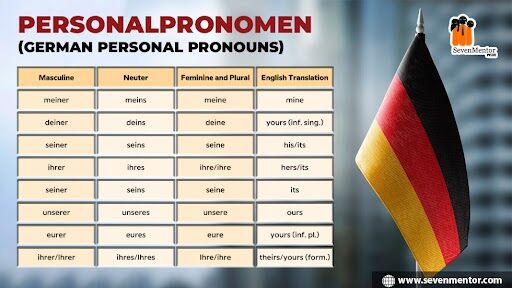Personalpronomen (German Personal Pronouns)
Master Personalpronomen (German Personal Pronouns) with our comprehensive guide. Enhance your German skills and improve your fluency with expert tips and examples.
The “first person”: ich and wir (I and we)
The pronoun you’ll use to talk about yourself from the very beginning is the personal pronoun “I” – or ich in German. In grammar terms, we call it the “first person singular”. When referring to ourselves and others at the same time, we use the personal pronoun “we” – or wir in German. This is known as “first person plural”.
Let’s look at a few examples:
- Ich heiße Anna. (My name is Anna.)
- Ich wohne in Dortmund. (I live in Dortmund.)
- Wir kaufen einen Computer. (We buy a computer.)
- Wir wohnen in Duisburg. (We live in Duisburg.)
For Free, Demo classes Call: 02071171747
Registration Link: German Language Classes in Pune!
The “second person”: du, ihr and Sie (you)
Translating the personal pronoun “you” can be a bit confusing for English speakers. That’s because we have three different personal pronouns that all mean “you” in German.
- First of all, we use the German personal pronoun du to talk to a single person that we know well, or to a child.
Example: Kommst du zur Geburtstagsparty? (Are you coming to the birthday party?).
- To talk to more than one person we know well, or to more than one child at a time, we use the pronoun ihr.
For example, a teacher could ask the class: Habt ihr eure Hausaufgaben gemacht? (Did you [all] do your homework?).
Or, you could ask your friend and his wife: Wohin fahrt ihr diesen Sommer? (Where are you [both] going this summer?).
- To talk to one or more people in a formal setting, we use Sie – did you notice the capital S?
For example, you could ask: Sind Sie Herr Müller? (Are you Mr. Müller?).
Note: Learn the names of colors in German with our easy-to-follow guide. Enhance your vocabulary and improve your language skills with fun and engaging lessons.
The “third person”: er, sie and es (he, she and it)
At first, it might seem that the three English pronouns he/she/it are the same as the German pronouns er/sie/es. However, there is a special quirk in German because, as you might remember, all things have a gender in the German language.
Therefore, the personal pronoun always has to match the gender of your noun. In English, we’d say: “The lamp is broken, it was old”. In German, however, die Lampe (the lamp) is feminine, so we say: Die Lampe ist kaputt, sie war alt.
This is a lot to digest, but the examples below will help:
- Masculine: Der Baum ist alt. (The tree is old.)
→ Er ist alt. (It is old. / “He is old.”) - Feminine: Die Kirche ist alt. (The church is old.)
→ Sie ist alt. (It is old. / “She is old.”) - Neuter: Das Buch ist alt. (The book is old.) → Es ist alt. (It is old.)
Important to know: sie can also mean “they” (this is called the “third person plural” in grammatical terms). But luckily for you, it doesn’t matter if you are talking about masculine, feminine or neuter nouns or people in the plural: sie is always correct.
- Die Häuser sind alt. (The houses are old.) → Sie sind alt. (They are old.)
- Die Männer sind jung. (The men are young.) → Sie sind jung. (They are young.)
The double meaning “she” and “they” may be a bit confusing, but the verb forms that go with each one tell us exactly which one is meant. As you’ve likely noticed already, context really matters in German!
Here are some example sentences with different meanings for sie:
- Sie ist traurig. (She is sad).
- Sie sind traurig. (They are sad.)
- Sie kommt aus Ungarn. (She is from Hungary.)
- Sie kommen aus Ungarn. (They are from Hungary.)
Do watch our latest video on German Language Course in Pune
Author:
Siddhi Ghale
© Copyright 2021 | SevenMentor Pvt Ltd.
Call the Trainer and Book your free demo Class For German Language
Call now!!!

